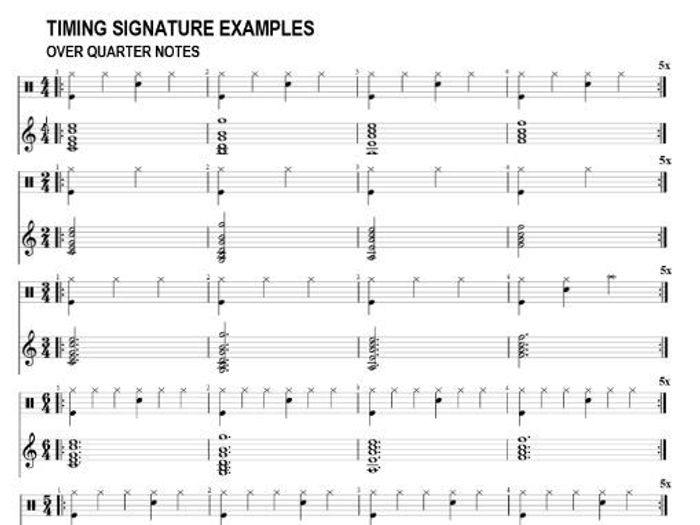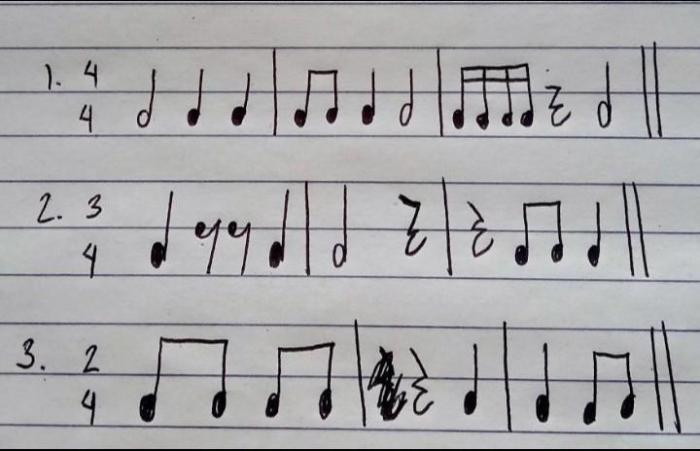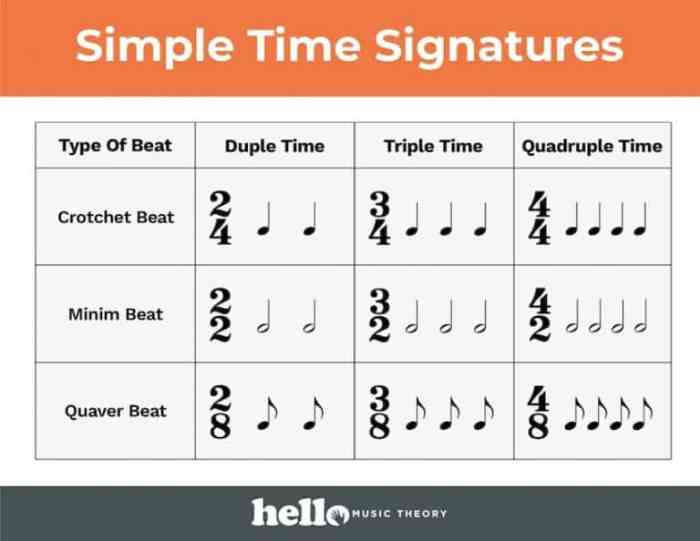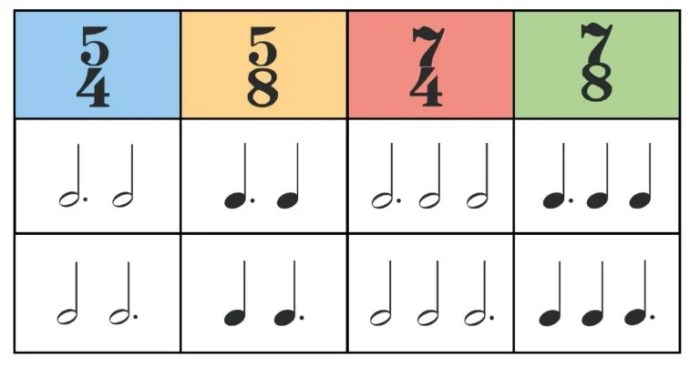Lesson 10 time signatures 3/4 – Embark on a musical journey as we delve into Lesson 10: Time Signatures 3/4. This rhythmic adventure will unveil the secrets of this intriguing time signature, guiding you through its unique characteristics, applications, and advanced concepts.
Prepare to master the intricacies of 3/4 time, unraveling its rhythmic patterns, accents, and notation. Explore its versatility across musical genres and discover how it enhances musical expression through syncopation and polyrhythms.
Introduction

Time signature is a musical notation that indicates the number of beats per measure and the type of note that receives one beat. In 3/4 time, there are three beats per measure, and the quarter note receives one beat.
This time signature is often used in waltzes, marches, and other types of music with a strong, steady beat.
The time signature is written as a fraction, with the top number indicating the number of beats per measure and the bottom number indicating the type of note that receives one beat.
In 3/4 time, the top number is 3 and the bottom number is 4, which means that there are three beats per measure and the quarter note receives one beat.
The time signature is placed at the beginning of the staff, after the clef and key signature.
Characteristics of Time Signature 3/4

Time signature 3/4 is characterized by its distinctive rhythmic pattern and accentuation. It creates a sense of movement and flow in music.
Rhythmic Pattern
In 3/4 time, each measure consists of three beats. The first beat is typically accented, while the second and third beats are unaccented. This rhythmic pattern creates a “strong-weak-weak” feel.
Accentuation
The accentuation in 3/4 time is typically placed on the first beat of each measure. This accent helps to establish the meter and drive the rhythm forward.
Notation and Symbols
Musical notation uses specific symbols to represent time signatures. In the case of 3/4 time, the following symbols are employed:
Numerator
The numerator, written as the top number, indicates the number of beats per measure. In 3/4 time, the numerator is always 3, signifying three beats per measure.
Denominator
The denominator, written as the bottom number, represents the type of note that receives one beat. In 3/4 time, the denominator is 4, indicating that a quarter note (crotchet) receives one beat.
Placement on the Staff
The time signature is typically written at the beginning of a musical piece, after the clef and key signature. It is placed on the staff as a fraction, with the numerator above the denominator.
Applications in Music: Lesson 10 Time Signatures 3/4

Time signature 3/4 finds widespread use in various musical genres and styles. Its distinctive rhythmic pattern lends itself well to a range of musical expressions.
In Lesson 10, we’re diving into 3/4 time signatures, which give music a lilting, waltz-like feel. Speaking of waltzing, have you heard of Brian’s Bazaar Sea of Thieves ? It’s a swashbuckling adventure with a soundtrack that’ll make you want to dance on the high seas.
But back to our musical journey, 3/4 time signatures add a touch of elegance and movement to any composition.
Musical Genres Using 3/4 Time Signature
Some notable musical genres that commonly employ 3/4 time signature include:
- Waltzes: This elegant and graceful dance music is characterized by its 3/4 rhythm, creating a swaying and lilting effect.
- Polkas: These lively and energetic dances from Central Europe are often written in 3/4, with a fast and upbeat tempo.
- Mazurkas: Originating from Poland, mazurkas are traditional folk dances that typically feature a 3/4 time signature.
- Military marches: Many military marches adopt 3/4 time signature, contributing to their rhythmic and steady pace.
- Some folk songs: Traditional folk songs from various cultures around the world often utilize 3/4 time signature.
Famous Compositions in 3/4 Time Signature
Throughout musical history, numerous famous compositions have been written in 3/4 time signature. Here are a few notable examples:
- Johann Strauss II, “The Blue Danube”: This iconic waltz is one of the most recognizable pieces of classical music, capturing the elegance and charm of 3/4 time.
- Frédéric Chopin, “Minute Waltz”: As the name suggests, this virtuosic piano piece is played at a rapid pace in 3/4 time, showcasing Chopin’s technical brilliance.
- Ludwig van Beethoven, “Für Elise”: This beloved piano piece features a gentle and flowing melody in 3/4 time, conveying a sense of serenity and nostalgia.
- The Beatles, “All You Need Is Love”: This classic pop song is written in 3/4, adding to its upbeat and optimistic mood.
Relationship to Other Time Signatures

Time signature 3/4 shares similarities and differences with other common time signatures, particularly 4/4 and 2/4.
Comparison with 4/4 Time Signature, Lesson 10 time signatures 3/4
Both 3/4 and 4/4 time signatures have three beats per measure. However, the beats are grouped differently:
- In 3/4, the beats are grouped in threes (one strong beat followed by two weak beats).
- In 4/4, the beats are grouped in fours (one strong beat followed by three weak beats).
This difference in grouping affects the rhythmic feel and emphasis of the music.
Comparison with 2/4 Time Signature
3/4 and 2/4 time signatures both have two beats per measure. However, the beats are of different lengths:
- In 3/4, each beat is a quarter note (one beat per quarter note).
- In 2/4, each beat is a half note (two beats per half note).
This difference in beat length creates a different rhythmic feel and tempo.
Rhythmic Exercises

Developing a solid grasp of time signature 3/4 requires engaging in rhythmic exercises. These exercises are crafted to enhance your understanding of the rhythmic patterns and subdivisions within this time signature.
Exercises for Different Rhythmic Patterns
- Clapping Patterns:Begin by clapping a simple 3/4 rhythm (e.g., quarter note, quarter note, half note). Gradually introduce variations by incorporating different note values (e.g., eighth notes, dotted quarter notes) and syncopated rhythms.
- Body Percussion:Utilize body parts as percussive instruments. Tap your hands, stomp your feet, and clap to create rhythmic patterns in 3/4. Experiment with different combinations and variations.
- Playing Instruments:Use musical instruments such as drums, keyboards, or guitars to practice playing rhythms in 3/4. Focus on maintaining a steady beat and exploring different rhythmic patterns.
Exercises for Subdivisions
- Counting Subdivisions:Practice counting the subdivisions of a 3/4 measure aloud (e.g., “1-2-3, 1-2-3”). This helps internalize the rhythmic structure and develop a sense of pulse.
- Dividing the Measure:Subdivide the measure into smaller units (e.g., eighth notes or sixteenth notes). Practice playing or singing rhythms that align with these subdivisions.
- Syncopated Subdivisions:Experiment with syncopated rhythms that emphasize subdivisions other than the downbeat. This challenges your rhythmic coordination and strengthens your understanding of 3/4 time.
Advanced Concepts

Time signature 3/4 provides a solid foundation for exploring advanced rhythmic concepts that enhance musical expression. Syncopation and polyrhythms are two such concepts that add depth and complexity to compositions.
Syncopation involves placing accents on unexpected beats, creating a sense of rhythmic displacement and interest. Polyrhythms, on the other hand, involve playing two or more different rhythms simultaneously, resulting in a captivating interplay of rhythmic patterns.
Syncopation
- Syncopation in 3/4 time can be achieved by placing accents on the second or third beat, creating a syncopated effect.
- This technique adds rhythmic interest and drive to the music, making it more engaging and dynamic.
Polyrhythms
- Polyrhythms in 3/4 time involve playing a 2/4 pattern against a 3/4 pattern, or vice versa.
- This creates a complex and layered rhythmic texture that adds depth and intrigue to the music.
Question Bank
What is the definition of time signature 3/4?
Time signature 3/4 indicates three beats per measure, with each beat receiving the value of a quarter note.
How is the accent typically placed in 3/4 time?
The primary accent falls on the first beat of each measure, with a secondary accent on the third beat.
Can you provide an example of a famous composition written in 3/4 time?
Ludwig van Beethoven’s “Für Elise” is a renowned piece written in 3/4 time.